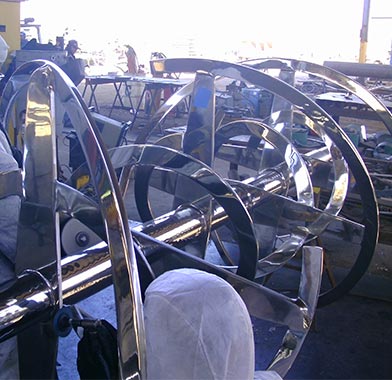Table of Contents
- Why Industrial Blenders Are Essential
- Types of Industrial Blenders
- Applications in the Food Industry
- Blending in Chemical and Pharmaceutical Sectors
- Eco-Friendly and Sustainable Practices
- Recent Technological Advances
- Choosing the Right Blender for Your Needs
- Future Trends in Industrial Blending
Why Industrial Blenders Are Essential
The significance of industrial blenders in modern manufacturing cannot be overstated. These machines are the backbone of numerous industries by facilitating the efficient mixing of materials to produce consistent, high-quality products. Blenders are crucial whether it’s the food industry blending spices to perfection or the pharmaceutical sector ensuring uniformity in medicinal compounds. Their role is vital as global markets demand quality and rapid production capabilities to meet consumer needs. Moreover, as industries continue to innovate, the versatility of industrial blenders helps to keep pace with these changes, adapting to new processes and improving productivity.
Types of Industrial Blenders
Navigating the myriad industrial blenders available can be daunting, but optimizing manufacturing operations is essential. Each blender type has distinct features serving unique purposes:
- Ribbon Blenders: Recognized for their superior ability to mix powders and granules, they are foundational in bulk processing facilities. Their unique design ensures a thorough and homogeneous blend, minimizing product variations.
- V-Blenders: These blenders, characterized by their V-shaped chambers, are optimal for gentle mixing. They prevent particle degradation while ensuring uniform mixing, which is especially crucial in the pharmaceutical industry, where product integrity is key.
- Paddle Blenders: Designed with large paddles, these blenders provide a slower, more measured mixing action. They are ideal for applications where maintaining the texture of ingredients is imperative, such as certain food products.
Choosing the right blender hinges on understanding the production process’s precise requirements, such as material properties and desired outcomes.
Applications in the Food Industry
Industrial blenders are indispensable tools in the food industry, ensuring uniform taste, texture, and quality across production lines. These machines are pivotal in various processes, from mixing spices to crafting dough with consistent texture. The demand for uniformity is driven by consumers who expect their favorite products to taste the same every time. Advanced blending technologies have thus been developed to meet these high standards, as illustrated in several innovative food processing methods. These advancements not only enhance product quality but also optimize the efficiency of production lines, reducing the cost and time associated with batch processing. Thus, industrial blenders help manufacturers satisfy consumer demands while enhancing operational efficiency and cost-effectiveness.
Blending in Chemical and Pharmaceutical Sectors
The necessity of precision blending in the chemical and pharmaceutical sectors cannot be overlooked. In these industries, consistency is not just a quality marker but a safety concern. Industrial blenders here are calibrated to maintain stringent tolerances in mixing, ensuring that every batch complies with the requisite standards and regulatory guidelines. Such accuracy is critical when blending active ingredients with excipients in medicines or creating chemical compounds that must adhere to specifications. The reliability of industrial blenders provides peace of mind that the end products are effective and safe for use, fundamentally supporting public health and safety efforts.
Eco-Friendly and Sustainable Practices
The push towards sustainability in manufacturing is gaining momentum, and industrial blenders are a key aspect of this trend. Recent innovations have focused on creating energy-efficient models that reduce environmental impact and significantly save costs. By utilizing less energy, these machines help manufacturers lower their carbon footprint, aligning with broader eco-friendly initiatives in global manufacturing practices. Integrating sustainable practices into industrial operations is both environmentally prudent and economically advantageous, appealing to a growing consumer base that values sustainability and corporate responsibility.
Recent Technological Advances
Thanks to technological advancements, the industrial blending landscape is continuously evolving. Introducing bright blenders has brought about unparalleled improvements in precision and efficiency. These machines now have sensors and IoT capabilities, allowing real-time monitoring and control of blending processes. Such technologies enable manufacturers to optimize the production process by adjusting parameters on the fly, reducing waste, and improving throughput. The integration of data analytics further enhances these capabilities, paving the way for predictive maintenance and reducing the likelihood of costly downtimes by preemptively addressing potential mechanical issues.
Choosing the Right Blender for Your Needs
Selecting the right industrial blender is an integral step that can significantly impact the success of manufacturing processes. When choosing a blender, factors like the nature of the materials, batch size, and specific production requirements must be considered. An accurate evaluation ensures that the blender meets operational needs and aligns with long-term strategic goals, including sustainability and cost-effectiveness. With the right equipment, manufacturers can achieve greater product consistency and process efficiency, enhancing overall business performance.
Future Trends in Industrial Blending
The future of industrial blending is poised for transformation with the advent of artificial intelligence and machine learning technologies. These innovations promise to introduce highly adaptive blending solutions that can tune their operations based on complex algorithms and machine learning models. Such progress is expected to streamline production processes further, heighten precision, and open new possibilities in customization and efficiency. The integration of these advanced technologies will enable manufacturers to maintain a competitive edge, ensuring they remain at the forefront of the industry, ready to meet the challenges of tomorrow’s manufacturing landscape.

